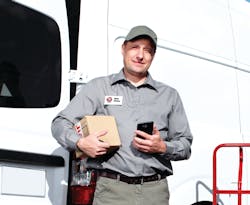This article originally appeared in the May 2022 issue of Security Business magazine. When sharing, don’t forget to mention Security Business magazine on LinkedIn and @SecBusinessMag on Twitter.
The pandemic has opened the eyes of many to the convenience of having everything they need delivered right to their doorstep. While this caused many businesses to see a massive surge in demand, it often meant hiring people who are willing to work solo to make those deliveries.
Unfortunately, those lone workers can be targets, creating safety issues as well as additional liability and risks for the companies who employ them.
Across the country, the headlines – most within the last two years – don’t lie: A retail delivery driver attacked by three teenagers in Buffalo, N.Y.; a Mississippi delivery driver shot at while on the job; a Philadelphia pizza driver ambushed and left in critical condition.
A Shift in Safety Protocols
With statistics showing 23 million lone workers in the United States alone, the value of Personal Emergency Response System (PERS) devices in the workplace has never been clearer. The most recent data from the Occupational Safety and Health Administration (OSHA) shows nearly 50% more assaults happen in the healthcare and social services sectors, but retail and delivery workers also bore the brunt of these attacks, with 44% of lone workers reporting personal safety issues.
In the ever-evolving, post-pandemic world, the attitude towards PERS devices has shifted. The growing need to do more with less coupled with the increasing importance of hiring and keeping quality employees is driving companies to ensure employees in the field are safe in the event of an attack or robbery. This includes protecting delivery drivers, those working alone at night, solitary workers covering stores during low-traffic times, and lone workers potentially required to enter a stranger’s home.
Some major corporations have addressed this problem by updating standard operating procedures and protections to include mobile PERS devices for workers.
The Benefits
Protecting employees is easily the most important responsibility of any company, and that is the most straightforward pitch any integrator can make to companies and corporations looking to provide that care in their workplace community.
The beauty of installing PERS technology is that it is the most integrated way of protecting workers. Here are four things to keep in mind when helping a customer choose a lone worker solution:
1. Ease of Use: PERS devices cut down the time to make key, in-the-moment decisions during an attack or any other fearful situation.
2. Compliance: Leveraging one universal product creates a company-wide standard for safety protocols and procedures. Every employee receives the same training, which in turn, means every employee receives the same quality response in case of an emergency.
3. Reliability: In the event of an attack or fall, employers and employees want something dependable. One push of a button makes the call to a company care center or local dispatch and immediately sends location to the right people.
4. Discreet: In the event of a dangerous situation, the last thing a lone worker needs is to draw further attention to their attempt to get help. Some devices are equipped for ‘silent mode’ and provide vibrations, not sound, as feedback that a call for help has been placed and received.
Mobile PERS vs. Smartphone Apps
We live in a day and age where smartphones are capable of nearly anything; however, smartphones lack the standardization and ease of use needed for many emergency situations.
People do not use the same phone carrier, or the same brand and model of phone – thus, there is no way to set a universal safety standard as a company. Pairing a Bluetooth button to every different phone adds complexity and uncertainty to any process.
A smartphone also only works well if you are looking at it. Imagine a highly stressful and dangerous scenario when you need help but cannot look at your phone. A one button PERS device provides immediate connection and feedback. Companies supporting lone workers tend to find that a better solution.
Increased Adoption on the Horizon
Solo work is becoming more frequent and common across many industries, including real estate, healthcare, social services, education, construction, utility, and retail; however, there are few rules and regulations in place for these industries leveraging the lone worker model. Could legislation lead the way to the future for the PERS industry, where protecting lone workers dramatically increases deployment?
Canada recently amended its federal labor laws, saying organizations “could be criminally liable for not taking reasonable measures to protect their employees’ safety.”
In the United States hospitality industry, some states and cities have mandated the use of a panic button to protect lone workers – including Chicago, Sacramento, Miami Beach and Seattle.
As of now, without established legal standards in place across all industries, it remains the responsibility of an employer to take action to care for their workers – especially those without direct, in-person support during their shift.
For integrators, the pitch is that more employers will recognize the need to add to the care they provide for employees and fill the safety gap for lone workers. With that, comes more growth and more innovation.
Ko Matsuo is the Numera PERS product line manager for Nice/Nortek Control. Request more about the company at www.securityinfowatch.com/10215766.
About the Author

Ko Matsuo
Ko Matsuo is the Numera PERS product line manager for Nice/Nortek Control. Request more about the company at www.securityinfowatch.com/10215766.
